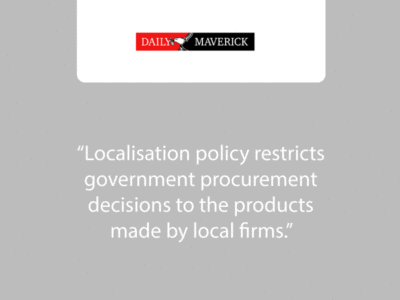
The case for localisation rests on the idea that protection of, and support for, specific industries will allow firms located in those industries to develop rapidly and become exporters. However, there is no evidence that the Department of Trade, Industry and Competition’s approach seeks to discriminate between industries in which comparative advantage might be developed and those in which this is not possible.
In recent months the government has articulated an approach to economic recovery and growth that can be encapsulated in the phrase “industrialisation through localisation”. This envisages growth of output and industrial capabilities flowing from policies that seek to redirect demand away from imports towards locally produced goods.
In this regard, the Department of Trade, Industry and Competition (DTIC) has designated nearly 30 products/product categories that government agencies must purchase either solely or in the main from local producers. At the same time, the “social partners” have reached an agreement at the National Economic Development and Labour Council that they will reduce South Africa’s non-petroleum imports by 20% over the next five years by redirecting spending to local manufactured goods.
Proponents of localisation argue that the switching of demand from foreign to domestic products has the potential to increase GDP, expand employment and sow the seeds for the development of increased industrial capability.
A new report by the Centre for Development and Enterprise, The Siren Song of Localisation: Why localisation policy will not lead to industrialisation, disputes those claims. It argues that the benefits of localisation are overstated while the costs are dramatically understated.
The case for localisation rests on the idea that protection of, and support for, specific industries will allow firms located in those industries to develop rapidly and become exporters. However, there is no evidence that the DTIC’s approach seeks to discriminate between industries in which comparative advantage might be developed and those in which this is not possible. As with much of the department’s industrial policy, every industry appears to be treated as a priority. Its decision to designate a product for local procurement by government agencies appears to be made on the basis of “evidence indicating that the government buys [the] product which is under distress caused by imports which displace local production and jobs.” This indiscriminate, one-size-fits-all approach to protectionism is a misguided, inefficient and expensive development strategy.
Localisation policy restricts government procurement decisions to the products made by local firms. Such a requirement is unnecessary unless, in its absence, the purchaser would have chosen to procure an imported product. It is reasonable to conclude, therefore, that the local product must be more expensive than the comparable import and/or of inferior quality. Requiring that a more expensive and/or an inferior good must be purchased raises the cost of doing business and the costs of delivering services. In either case there are negative implications for those who use products designated for localisation, and it is consumers, taxpayers or businesses who must ultimately foot the bill.
Proposals for localisation feature prominently in the industry master plans that the DTIC has been developing in conjunction with organised business and labour in a number of sectors over the past few years. A common feature of the master plans is their blindness or indifference to the implications of their proposals for the rest of the economy. When local content targets are included in master plans, the effect is often higher costs for consumers or downstream users of the industry’s products. The oft-repeated argument that master plan processes can help address bottlenecks in local value chains needs to be balanced by an awareness that there is a clear risk that the process serves to protect incumbent firms from further competition.
Apart from imposing higher costs, the DTIC’s quantity-based localisation restrictions, which stipulate that a certain percentage of designated goods must be sourced locally, reduce incentives on firms to become more efficient and innovate new products. Their market is guaranteed, and firms can secure a share of the market without having to become more efficient or to innovate.
The net effect is that one of the risks of localisation is that policy ends up supporting very inefficient firms – a risk that is especially acute when markets are dominated by a small number of players.
Another localisation-related cost is incurred when technical and design differences between a local product and the comparable imported item require that changes must be made to the design parameters of an entire project. A local pump or local piping, for example, might have technical specifications that are different from the design parameters of the most appropriate product, resulting in cascading changes elsewhere that will raise costs of production and/or maintenance or will affect overall operations.
Raising costs and/or lowering the quality of their goods obviously has implications for firms’ ability to compete in export markets, suggesting that an entirely plausible effect of localisation policy will be a reduction, rather than an expansion, in exports.
The DTIC justifies localisation policies by claiming that South Africa has an “over-propensity” to import. It argues that GDP would rise by five percentage points if non-petroleum imports were reduced by 20%. They report having secured agreement with business and labour to achieve this goal within five years.
There are several problems with the DTIC’s reasoning.
First, the data do not support the DTIC’s claim that South Africa devotes a disproportionately large share of its GDP to imports. South Africa’s imports as a share of GDP are very much in line with other countries.
Second, a cursory glance at the data reveals that there is a very strong relationship between the value of countries’ imports and the value of their exports. The reason for this is obvious: global supply chains are complex and exporters have to import intermediate goods, components and capital equipment in order to export their output to the next link in the supply chain. Higher levels of imports are a sine qua non of higher exports. This is most readily apparent in the sector that makes up the largest fraction of industrial exports in South Africa: motor vehicles.
Third, the intimate link between imports and exports means that the opportunities for raising GDP by reducing imports are illusory. Imports of intermediate and capital goods are crucial inputs in production and are associated with higher-value-added South African firms. The competitiveness of exporting firms, particularly of manufactured goods, is also dependent on access to high-quality, competitively priced intermediate inputs. Since localisation will restrict access to competitively priced imports and result in higher production costs, the policy is, in effect, an anti-export strategy. It will also have the indirect effect of reducing competitiveness and production in downstream industries that use protected goods as inputs in production.
One argument made for localisation is that it is necessary to protect infant industries from international competition so that they have the time, space and markets to build the requisite capabilities and know-how. Proponents of this argument point out that protectionist policies under apartheid led to the emergence of Sasol and Iscor (now ArcelorMittal). Infant-industry protection can succeed in fostering globally competitive firms, but frequently they do not. In any event, these companies’ existence does not prove the case for infant-industry protection leading to greater competitiveness and benefits for the local economy: competition enquiries into both Sasol and ArcelorMittal have sought to show that import-parity pricing by these firms has raised production costs for local industries.
The evidence that protectionism works to expand industries is also contradicted by the clothing industry, which operates behind high tariff barriers and yet has seen continued decline in output and employment, including a 10% decline in jobs between 2015 and 2019.
South Africa’s poor economic performance has nothing to do with an “over-propensity” to import, and everything to do with a range of well-known and self-inflicted policy and governance injuries. The claims made on localisation’s behalf are simply not credible.
The DTIC seeks to justify the localisation policy by a focus on the occasional success story, and its approach has been supported by the firms that benefit. The broader costs of the policy, to be borne by the government, by South African consumers, by non-insider firms and by exporters, have been ignored.
Protection, import-substitution and industrialisation through localisation all have spotty records as vehicles for promoting development, with many more misses than hits. By contrast, exports have been integral to successful development everywhere. In raising costs, these policies also directly contradict promises to reduce the cost of doing business in South Africa.
South Africa’s future growth will similarly be heavily dependent on growing exports – particularly of non-traditional exports. Seeking to replace imports is no substitute for building the capabilities for exporting. An undue focus on localisation and on prohibiting imports will weaken our export capabilities since we will not have the intermediate goods and capital equipment needed to make competitively priced goods for global markets.
Localisation should be called what it is: an anti-export strategy, one that will only further constrain our future development.
Ann Bernstein is head of the Centre for Development and Enterprise. This article is based on a new CDE report, The Siren Song of Localisation: Why localisation policy will not lead to industrialisation.
This article appeared in Daily Maverick




